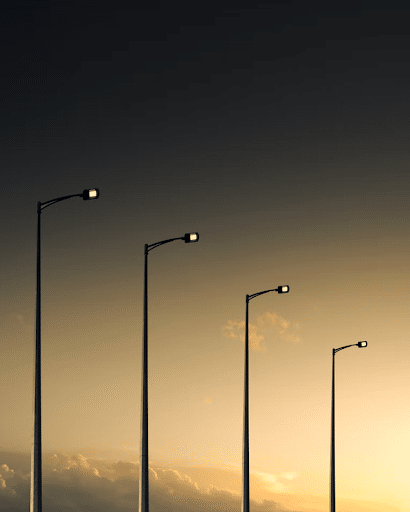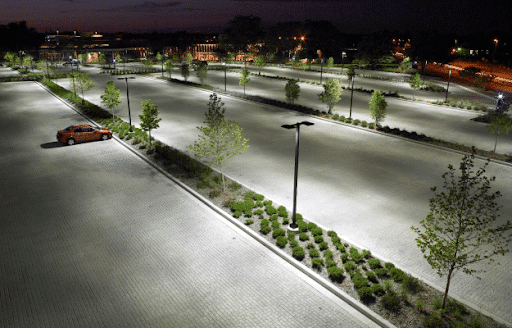Exterior lighting refers to lighting fixtures that are designed for use in parking lots, building exteriors, and other outdoor areas. The primary function of commercial exterior lighting is to provide visibility, safety, and security to businesses, employees, and customers. Properly designed and installed commercial exterior lighting can enhance the aesthetics of a property, promote energy efficiency, and reduce maintenance costs.
The Importance of Exterior Lighting
Commercial exterior lighting plays a crucial role in ensuring the safety and security of businesses and their customers. Well-lit outdoor areas can deter criminal activity, reduce accidents, and improve the visibility of drivers and pedestrians. Additionally, properly designed exterior lighting can enhance the aesthetic appeal of a property, promote energy efficiency, and reduce the cost of maintenance.
Types of Commercial Exterior Lighting
There are several types of commercial exterior lighting fixtures available, each designed to meet specific lighting needs. Below are some of the most common types of commercial exterior lighting fixtures:
A. Floodlights
Floodlights are high-intensity lighting fixtures that provide broad coverage and are commonly used to illuminate large outdoor areas, such as parking lots, sports fields, and building facades. Floodlights are available in a variety of sizes and configurations, and some models can even be equipped with motion sensors for added security.
Pros: Floodlights are very effective at providing broad coverage, making them ideal for illuminating large outdoor areas. They are also relatively easy to install and can be used with a variety of mounting options.
Cons: Floodlights can be a concern in areas where light pollution is an issue. Additionally, they can be expensive to operate, especially if they are left on for extended periods of time.
You can read more about flood lights, and other commercial lighting options, in our blog about LED parking lot light fixtures.
B. Wall Packs
Wall packs, like our GL Wall Pack, are fixtures that are mounted on walls and provide a wide range of illumination. They are commonly used for exterior lighting in doorways or on building facades in commercial or industrial applications. Wall packs come in a range of sizes and wattages, and are designed to be weather-resistant and durable.
Their primary function is to provide uniform and bright light outward, making them suitable for illuminating large outdoor spaces such as parking lots, walkways, and exteriors near the building. Wall packs can be used for security purposes, as well as to highlight architectural features of buildings.
C. Area Lights
Area lights are outdoor lighting fixtures that provide a wide beam of light and are used to illuminate large areas. These fixtures are often used to light up parking lots, walkways, and other outdoor spaces where people need to move around safely.
Area lights can be pole-mounted or wall-mounted, and are available in a range of wattages and sizes. They are designed to be weather-resistant and durable, and can also be used to highlight landscaping or architectural features.
D. Roadway
Roadway lights are outdoor lighting fixtures that are designed to illuminate roadways and highways. They are typically mounted on poles at a height of 25 to 40 feet and are designed to provide a uniform and bright light to the road surface below.
Roadway lights are also used to provide drivers with clear visibility of the road ahead, during nighttime and low-light conditions. They are available in a range of wattages and sizes, and are designed to be weather-resistant and durable, with easy access to electronics for quick maintenance.

Factors to Consider When Choosing Commercial Exterior Lighting
A. Purpose and Functionality
First and foremost, consider the purpose and functionality of the lighting. Will it be used for security and safety purposes, or simply for aesthetic appeal? Is it intended to highlight specific features of the building or outdoor space? By understanding the purpose and desired functionality of the lighting, you can better select the appropriate fixtures and lighting types.
B. Energy Efficiency
You should always consider energy efficiency when selecting exterior lighting. Energy-efficient lighting options can help to reduce operating costs and minimize environmental impact. Look for lighting fixtures that have high-efficiency ratings.
C. Durability and Maintenance
Exterior lighting fixtures are exposed to the elements and can be subjected to wear and tear over time. Selecting durable fixtures that are designed to withstand harsh weather conditions and other environmental factors is crucial when designing your outdoor lighting.
For example, EPA is a measure of the wind resistance of an object or structure, which must be taken into account to ensure that the mounting hardware can withstand heavy wind load. The EPA can be calculated by multiplying the projected surface area by the drag coefficient.
Additionally, keeping up with the maintenance requirements of the fixtures and choosing options that are easy to maintain and repair can prolong the lifecycle of your lighting system.
D. Aesthetics and Design
Finally, aesthetics and design should be considered when selecting exterior lighting fixtures. The right lighting can enhance the overall look and feel of a building or outdoor space. Always choose fixtures and finishes that complement the design of the building and outdoor area and contribute to the overall desired ambiance of your space.
Best Practices for Commercial Exterior Lighting
Once you have selected the appropriate exterior lighting fixtures for your business, you should follow best practices to ensure optimal performance and safety. Here are some tips for commercial exterior lighting best practices:
A. Proper Placement and Direction
The placement and direction of exterior lighting fixtures can greatly impact their effectiveness. Be sure to place fixtures in locations that provide the desired coverage and direction. For example, floodlights may be used to illuminate a large area, while wall packs may be used to light specific sections of a building or outdoor area. Choosing the correct optics will ensure you have the best solution for your space.
B. Optimal Color Temperature and Brightness
The color temperature and brightness of exterior lighting can have a significant impact on visibility and safety, so make sure you choose fixtures that provide the appropriate color temperature and brightness for the intended use. For example, a lower color temperature may be preferable for a warm and inviting outdoor seating area, while a higher color temperature may be more appropriate for security lighting.
C. Use of Motion Sensors and Occupancy Sensors
Motion and occupancy sensors, such as our ZT4, can help to reduce energy consumption, and improve safety. Consider using motion sensors to activate lighting only when necessary, such as when someone is present in the area. Additionally, occupancy sensors can be used to dim or turn off lighting during times when there is no traffic to save energy and reduce operating costs.
D. Compliance with Regulations and Safety Standards
Finally, exterior lighting systems need to comply with all relevant regulations and safety standards. This includes ensuring that fixtures are properly installed and maintained and that they do not create a safety hazard for employees, customers, or the general public.
Conclusion
Commercial exterior lighting can sometimes be an afterthought, but by selecting the appropriate fixtures and following best practices, businesses of all types can build a lighting system that reduces operating costs and keeps their building, and its visitors, secure.
Take a look at our other blog post about commercial grade LED parking lot lights for more information. For the best selection of high-quality exterior lighting fixtures, contact our team at Solais Lighting.
